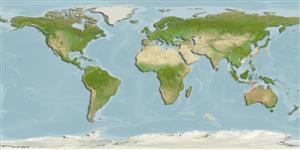>
Ophidiiformes (Cusk eels) >
Carapidae (Pearlfishes) > Pyramodontinae
Etymology: Pyramodon: Greek, pyramis = pyramid + Greek, odous = teeth (Ref. 45335).
Environment: milieu / climate zone / depth range / distribution range
Ekologi
laut batidemersal; kisaran kedalaman 250 - 385 m (Ref. 34024). Deep-water
Western Pacific: Japan to northern Australia.
Size / Weight / umur
Maturity: Lm ? range ? - ? cm
Max length : 36.0 cm TL jantan/; (Ref. 6347)
Eel-like, moderate to relatively deep body depth; a large single vomerine fang; pelvic fin rays present; swim bladder large, filling visceral cavity and extending past anus; dorsal and anal fin radials robust and elongate; dorsal fin anteriad or directly over anal fin origin; lacking rockerbone, cardiform teeth, and intrinsic swim bladder constrictions or tunic ridges (Ref. 34024). Margins of dorsal and anal fins edged in black over entire length; head and body generally unpigmented (Ref. 34024).
Uncommon species (Ref. 34024).
Nielsen, J.G., D.M. Cohen, D.F. Markle and C.R. Robins, 1999. Ophidiiform fishes of the world (Order Ophidiiformes). An annotated and illustrated catalogue of pearlfishes, cusk-eels, brotulas and other ophidiiform fishes known to date. FAO Fish. Synop. 125(18):178p. Rome: FAO. (Ref. 34024)
Status IUCN Red List (Ref. 130435)
ancaman kepada manusia
Harmless
penggunaan manusia
Perikanan: tidak ada kepentingan
Alat, peralatan
laporan khas
muat turun XML
Sumber internet
Estimates based on models
Preferred temperature (Ref.
123201): 10.9 - 12.9, mean 11.7 °C (based on 12 cells).
Phylogenetic diversity index (Ref.
82804): PD
50 = 0.5625 [Uniqueness, from 0.5 = low to 2.0 = high].
Bayesian length-weight: a=0.00102 (0.00046 - 0.00225), b=3.06 (2.88 - 3.24), in cm total length, based on all LWR estimates for this body shape (Ref.
93245).
Trophic level (Ref.
69278): 3.8 ±0.5 se; based on size and trophs of closest relatives
Fishing Vulnerability (Ref.
59153): Low to moderate vulnerability (26 of 100).
